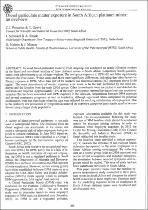JavaScript is disabled for your browser. Some features of this site may not work without it.
- ResearchSpace
- →
- Research Publications/Outputs
- →
- Conference Publications
- →
- View Item
| dc.contributor.author |
Pretorius, CJ

|
|
| dc.contributor.author |
Grove, T

|
|
| dc.contributor.author |
Schinkel, J

|
|
| dc.contributor.author |
Pronk, A

|
|
| dc.contributor.author |
Nelson, G

|
|
| dc.contributor.author |
Murray, J

|
|
| dc.date.accessioned | 2014-11-11T10:43:06Z | |
| dc.date.available | 2014-11-11T10:43:06Z | |
| dc.date.issued | 2014-08 | |
| dc.identifier.citation | Pretorius, C.J, Grove, T, Schinkel, J, Pronk, A, Nelson, G and Murray, J. 2014. Diesel particulate matter exposure in South African platinum mines: an overview. In: Proceedings of the Tenth International Mine Ventilation Congress, Sun City, Northwest Province, South Africa, 2-8 August 2014 | en_US |
| dc.identifier.uri | http://hdl.handle.net/10204/7755 | |
| dc.description | Proceedings of the Tenth International Mine Ventilation Congress, Sun City, Northwest Province, South Africa, 2-8 August 2014 | en_US |
| dc.description.abstract | Personal diesel particulate matter (DPM) sampling was conducted on nearly 300 mine workers in the diesel and non-diesel sections of three platinum mines in South Africa. Respiratory health questionnaires were administered to all of these workers. The workplace exposure to DPM did not differ significantly between the three mines. Within each shaft there were significant differences, indicating that other factors influence exposure to DPM. More than half of the workers had elemental carbon (EC) exposures above 0.160 mg/m3. The main determinants of worker exposure were found to be the task performed by the mine employee and the location from the main DPM source. Other determinants were inconclusive and detailed observations are required. Approximately 13% of the study participants reported having at least one respiratory symptom that has been associated with DPM exposure in the literature. Associations between DPM exposure and several respiratory symptoms as well as headaches, although significant when unadjusted for potential confounders, were not significant when the data were adjusted for smoking and duration of employment. Due to the rela-tively low prevalence of symptoms in some of the exposure categories these results need to be confirmed us-ing a larger study population. | en_US |
| dc.language.iso | en | en_US |
| dc.publisher | The Mine Ventilation Society of South Africa | en_US |
| dc.relation.ispartofseries | Workflow;13410 | |
| dc.subject | Diesel particulate matter | en_US |
| dc.subject | DPM | en_US |
| dc.subject | Respiratory health | en_US |
| dc.subject | Elemental carbon exposures | en_US |
| dc.title | Diesel particulate matter exposure in South African platinum mines: an overview | en_US |
| dc.type | Conference Presentation | en_US |
| dc.identifier.apacitation | Pretorius, C., Grove, T., Schinkel, J., Pronk, A., Nelson, G., & Murray, J. (2014). Diesel particulate matter exposure in South African platinum mines: an overview. The Mine Ventilation Society of South Africa. http://hdl.handle.net/10204/7755 | en_ZA |
| dc.identifier.chicagocitation | Pretorius, CJ, T Grove, J Schinkel, A Pronk, G Nelson, and J Murray. "Diesel particulate matter exposure in South African platinum mines: an overview." (2014): http://hdl.handle.net/10204/7755 | en_ZA |
| dc.identifier.vancouvercitation | Pretorius C, Grove T, Schinkel J, Pronk A, Nelson G, Murray J, Diesel particulate matter exposure in South African platinum mines: an overview; The Mine Ventilation Society of South Africa; 2014. http://hdl.handle.net/10204/7755 . | en_ZA |
| dc.identifier.ris | TY - Conference Presentation AU - Pretorius, CJ AU - Grove, T AU - Schinkel, J AU - Pronk, A AU - Nelson, G AU - Murray, J AB - Personal diesel particulate matter (DPM) sampling was conducted on nearly 300 mine workers in the diesel and non-diesel sections of three platinum mines in South Africa. Respiratory health questionnaires were administered to all of these workers. The workplace exposure to DPM did not differ significantly between the three mines. Within each shaft there were significant differences, indicating that other factors influence exposure to DPM. More than half of the workers had elemental carbon (EC) exposures above 0.160 mg/m3. The main determinants of worker exposure were found to be the task performed by the mine employee and the location from the main DPM source. Other determinants were inconclusive and detailed observations are required. Approximately 13% of the study participants reported having at least one respiratory symptom that has been associated with DPM exposure in the literature. Associations between DPM exposure and several respiratory symptoms as well as headaches, although significant when unadjusted for potential confounders, were not significant when the data were adjusted for smoking and duration of employment. Due to the rela-tively low prevalence of symptoms in some of the exposure categories these results need to be confirmed us-ing a larger study population. DA - 2014-08 DB - ResearchSpace DP - CSIR KW - Diesel particulate matter KW - DPM KW - Respiratory health KW - Elemental carbon exposures LK - https://researchspace.csir.co.za PY - 2014 T1 - Diesel particulate matter exposure in South African platinum mines: an overview TI - Diesel particulate matter exposure in South African platinum mines: an overview UR - http://hdl.handle.net/10204/7755 ER - | en_ZA |






